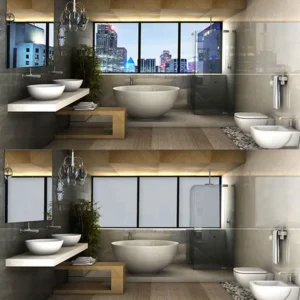Table of Contents
Smart windows, also known as switchable glass, are innovative technological solutions that have revolutionized the way we control light, privacy, and energy efficiency in our buildings. These high-tech windows are designed to adapt to changing environmental conditions and user preferences, offering enhanced comfort, convenience, and sustainability. In this article, we will delve deeper into what smart windows are, how they work, their benefits, and potential applications.
Understanding Smart Windows
Smart windows are a type of glazing technology that can alter their properties, such as transparency, opacity, and thermal insulation, in response to external stimuli or user commands. Unlike traditional windows, which have fixed characteristics, smart windows offer dynamic control over the amount of light and heat that enters a space, as well as the level of privacy desired.
1 How do Smart Windows Work?

Smart windows utilize various technologies to achieve their switchable properties. Here are some of the most common types:
- Electrochromic Windows: Electrochromic windows use an electrochromic film or coating that changes its tint when an electrical voltage is applied. The film typically contains metal ions that move between different oxidation states, altering its light-blocking capabilities. By controlling the voltage, users can switch between tinted and transparent states. This technology allows for precise control over the amount of light entering a space, reducing glare and optimizing daylighting.
- Photochromic Windows: Photochromic windows rely on the chemical properties of certain materials, such as spirooxazine or silver halides, to darken upon exposure to ultraviolet (UV) light. When the UV light is no longer present, the window gradually returns to its clear state. This technology is commonly used in transition lenses for eyewear. Photochromic windows can automatically adjust their tint based on the intensity of sunlight, providing optimal comfort and reducing the need for blinds or curtains.
- Thermochromic Windows: Thermochromic windows change their opacity in response to temperature variations. They consist of a special film or coating that alters its molecular structure upon heating or cooling, resulting in a change in color or transparency. These windows are particularly useful for passive solar heating applications. During hot weather, thermochromic windows can darken to block excess heat, while in colder temperatures, they can become more transparent to allow sunlight to warm the space.
- Liquid Crystal Windows: Liquid crystal windows utilize a layer of liquid crystal molecules sandwiched between transparent electrodes. By applying an electric field, the molecules align in a way that controls the passage of light. When the field is turned off, the liquid crystal returns to its original state, making the window transparent again. This technology offers fast switching times and precise control over light transmission, making it suitable for applications where rapid adjustments are needed, such as conference rooms or retail displays.
2 Benefits of Smart Windows
Smart windows offer numerous benefits, making them increasingly popular in both residential and commercial buildings. Here are some notable advantages:
- Energy Efficiency: By dynamically controlling the amount of heat and light that enters a space, smart windows contribute to reducing energy consumption. In cooling-dominated regions, tinted windows can minimize solar heat gain, while in heating-dominated areas, windows can maximize solar heat gain during colder months. This leads to lower energy bills and a smaller carbon footprint.
- Improved Comfort: Smart windows allow occupants to adjust the amount of natural light entering a room and reduce glare, creating a more comfortable environment. They also contribute to maintaining consistent indoor temperatures, reducing the need for excessive air conditioning or heating. With the ability to customize the level of privacy, occupants can enjoy a sense of personal space without sacrificing natural light.
- Enhanced Privacy: With the ability to switch between transparent and opaque states, smart windows provide users with increased privacy when needed. This feature is particularly useful for areas that require confidentiality, such as conference rooms or healthcare facilities. Smart windows can be controlled remotely or through automated systems, offering convenience and flexibility in managing privacy preferences.
- UV Protection: Certain types of smart windows can block harmful ultraviolet (UV) rays while still allowing visible light to pass through. This protects occupants and furnishings from the damaging effects of prolonged UV exposure, such as fading or skin cancer risks. UV-blocking smart windows help maintain a healthier indoor environment and preserve the longevity of interior finishes and furnishings.
3 Applications of Smart Windows
Smart windows have a wide range of applications in various industries. Here are some notable examples:
- Residential Buildings: Smart windows are increasingly integrated into modern homes, offering homeowners the ability to control privacy, daylighting, and energy efficiency. They can be particularly useful in bedrooms, bathrooms, or living spaces where privacy is a priority. Homeowners can adjust the tint of the windows based on their preferences and the time of day, allowing for a balance between natural light and privacy.
- Commercial Buildings: In commercial settings, smart windows can contribute to energy savings, occupant comfort, and aesthetic appeal. They are commonly used in office buildings, hotels, retail stores, and restaurants to create inviting and sustainable spaces. Smart windows can be programmed to adjust their tinting based on occupancy, reducing the reliance on artificial lighting and maximizing energy efficiency.
- Automotive Industry: Some high-end vehicles now feature smart windows that can switch between tinted and transparent states, reducing glare and enhancing passenger comfort. These windows can also aid in improving fuel efficiency by reducing the need for excessive air conditioning. In addition, smart windows in vehicles can provide privacy for passengers and protect them from harmful UV rays.
- Healthcare Facilities: Smart windows find applications in healthcare facilities by allowing doctors and patients to control privacy levels in consultation rooms, operating theaters, or patient rooms. Improved privacy contributes to a more comfortable and confidential environment. Smart windows can also be used to regulate lighting conditions in healthcare settings, promoting a healing environment for patients.
- Retail Display: Smart windows can be utilized in retail stores for dynamic displays and advertising. By adjusting the transparency or tint level, retailers can control the visibility of their products and create attention-grabbing showcases. Smart windows can also be synchronized with lighting systems to enhance the overall visual impact and create immersive shopping experiences.
In conclusion
Smart windows, or switchable glass, represent an exciting advancement in glazing technology. With their ability to adapt to changing environmental conditions and user preferences, these windows offer enhanced energy efficiency, comfort, and privacy. As technology continues to evolve, we can expect to see smart windows becoming more prevalent in various industries, contributing to sustainable and intelligent building designs.
4 FAQ
Q1: What are smart windows?
A1: Smart windows, also known as switchable glass, are windows that can alter their properties, such as transparency, opacity, and thermal insulation, in response to external stimuli or user commands.
Q2: How do smart windows work?
A2: Smart windows utilize various technologies such as electrochromic, photochromic, thermochromic, and liquid crystal to achieve their switchable properties. These technologies allow for precise control over the amount of light and heat entering a space, as well as the level of privacy desired.
Q3: What are the benefits of smart windows?
A3: Smart windows offer several benefits, including energy efficiency, improved comfort, enhanced privacy, and UV protection. They contribute to reducing energy consumption, maintaining consistent indoor temperatures, providing increased privacy when needed, and blocking harmful UV rays while still allowing visible light to pass through.
Q4: What are the applications of smart windows?
A4: Smart windows have a wide range of applications in residential buildings, commercial buildings, the automotive industry, healthcare facilities, and retail displays. They can be used to control privacy, daylighting, and energy efficiency in homes, offices, vehicles, healthcare settings, and retail stores, among others.
















